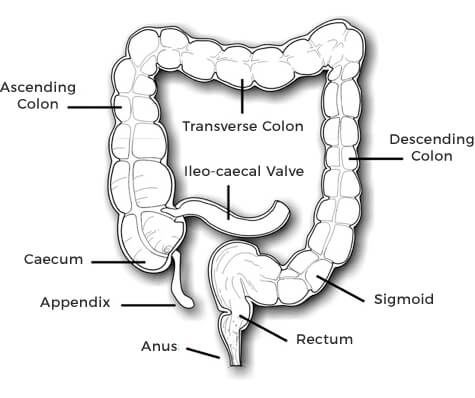The Colon
How the colon works

The colon (also called the large intestine) is an organ of the gastrointestinal tract. The job of the colon is to absorb water, fluids, to form stools, and to eliminate stools.
The colon is a hollow tube surrounded by muscles. It measures approximately 5 to 5-1/2 feet long and 2.5 inches in diameter.
It has a moist interior lining that protects nerves located in the colon wall. These nerves send and receive messages to the brain about content within the colon. The brain then directs the appropriate colonic action. In fact, Dr. Michael Gershon has called the colon our "second brain" in his book by the same title, The Second Brain.
Parts of the Colon & Movement of Waste
Several parts make up the continuous tube of the colon. Each part contributes to the movement of materials and the formation of stools. These parts include:
Ileocecal Valve: The ileocecal valve is a fold of mucus membrane at the entryway to the colon. It is located at the intersection of the small and large intestine. Materials from the small intestine pass into the colon through this valve.
Appendix: The appendix is attached to the bottom of the cecum. This is a twisted coiled tube that is about 3 inches long.
Cecum: The cecum is a type of reservoir that receives fecal material as it enters the colon. The cecum is located below the ileocecal valve at the base of the colon. The upper part of the cecum is open to the colon. The muscles of the cecum and the colon advance waste upward out of the cecum.
Ascending Colon: The ascending colon is located on the right side of the abdomen above the cecum. It is here that most of the water is absorbed by waste as it continues to move upward through the ascending colon. The ascending colon "ends" at the hepatic flexure where the colon bends to the left and connects to the transverse colon.
Transverse Colon: The transverse colon runs laterally across the abdomen below the belly button. As waste and fecal debris move across the transverse colon, stool begins to take form. The transverse colon "ends" at the splenic flexure where the colon bends again and connects to the descending colon which heads down the left side.
Descending Colon: The descending colon runs down the left side of the abdomen. Stools move down the descending colon. The stools are now more solid in form. It is here that waste may be stored for a time. The descending colon "ends" where it continues into the sigmoid colon.
Sigmoid Colon: The sigmoid colon angles to the right, curving down and inward to about the midline, then it curves slightly upward where it connects to the top of the rectum.
Muscular Action of the Colon
The colon's, muscular action moves materials throughout the colon. Muscles located on the exterior run along the length of the colon extending and contracting the colon accordingly. The interior muscles wrap around the colon in circular bands that distend and contract the colon- it is a motion similar to opening and closing a fist. There are five types of muscular action that takes place in the colon.
Haustral Churning: The colon wall has forms called haustra that expand and contract to squeeze waste forward creating larger masses as it moves along. Haustral churning facilitates fluid extraction and helps to advance waste through the colon.
Peristalsis: Joint muscular action of the interior and the exterior
muscles produce a wave-like motion, called peristalsis, that moves waste along the entire length of the colon.
Mass Peristaltic Reflex: Food in the stomach triggers a reflex in the
middle of the transverse colon that produces mass peristalsis. This
strong muscular action drives stools into the rectum.
Defecation Reflex: Movement of stools into the rectal sac, along with
pressure against the rectal wall signals the brain to trigger the defecation reflex (the signal for the body to "move" the bowel).
Co-operative Abdominal Effort: Defecation is aided by cooperative
and gentle pushing out of waste. It is important to avoid hard straining.